

This article is an excerpt from the Shortform book guide to "Confidence Man" by Maggie Haberman. Shortform has the world's best summaries and analyses of books you should be reading.
Like this article? Sign up for a free trial here.
What can we learn from Confidence Man, by Maggie Haberman? How did Donald Trump become the public figure that he is?
In Confidence Man by Maggie Haberman, we learn how Donald Trump’s family values led to a transactional mindset in relationships that fed his success in business and politics. To understand why Trump carried the presidency the way that he did, it helps to hear New York Times journalist Maggie Haberman’s analysis.
Continue reading to learn more from this biography of Donald Trump.
About Confidence Man
In Confidence Man by Maggie Haberman, the New York Times journalist explores Donald Trump’s public life and career. A longtime reporter on Donald Trump (and winner of a Pulitzer Prize for her coverage of his administration), Haberman explores the people, experiences, and environments that shaped the singular personality that would define his presidency.
| Critical Reaction to Confidence Man Confidence Man garnered a great deal of critical attention, commentary, and reaction upon publication in 2022. The Guardian commended Haberman for delving into the intricate dynamics of the Trump administration with meticulous detail. The review also noted the book’s success in shedding light on the psychology of Trump’s leadership. Haberman’s own New York Times provided a mixed assessment of the book. On the one hand, the review praised Haberman for her detailed and vivid portrayal of Trump and her ability to capture the chaos and complexity of his presidency. However, the review also noted that the book, despite its wealth of information, didn’t reveal any new insights into Trump’s character or the inner workings of his administration. Finally, The Washington Post celebrated Haberman’s unique insight into Donald Trump’s world, in particular her unique focus and emphasis on Trump’s rise in New York in the 1970s and 1980s. |
Donald Trump’s Early Years
Haberman writes that, growing up in the Trump household, Donald Trump learned the transactional nature of relationships—that people were only valuable insofar as they could benefit him. She notes that this mindset was fundamental to the New York real estate development world in which Trump grew up. His father excelled at cultivating political connections with local party leaders, elected officials, and judges. These connections were essential for obtaining the necessary tax breaks, easements, and permits for the family’s real estate ventures.
Donald Trump took these lessons to heart when he entered the family business in 1968, after finishing his studies at the University of Pennsylvania. In the 1970s, writes Haberman, Trump forged connections to key Manhattan power brokers, including then-Mayor Abe Beame. This enabled the Trump Organization to secure approximately $168 million worth of tax abatements from the city and state governments—an early demonstration to Trump of the government’s power to shower wealth on those who had the right political connections.
Cultivating a Public Image
By the late 1970s, writes Haberman, Trump was a rising star. She observes that he began cultivating a public image as a forward-thinking, get-things-done businessman with swagger. He believed positioning himself this way could make him a public symbol of success and prosperity. Haberman writes that Trump instinctively grasped the importance to his real estate business of media relations and of being seen as popular and well-liked. Thus, he made a point of making appearances in the elite New York City party scene, rubbing shoulders with celebrities and sharing salacious stories with the press.
Trump’s public image received a further boost with the completion of Trump Tower—a well-publicized luxury building—on Manhattan’s Fifth Avenue in 1983. The building’s location in the heart of Manhattan also brought him into contact with the city’s old guard financial and cultural elite. Trump resented and reviled the cultural establishment for their rejection of him as crass and boorish—but at the same time, he craved their approval and acceptance. Haberman notes that this love/hate dynamic with traditional elites continued into his later political career.
The Symbol of Success
In the 1980s, Donald Trump continued to actively shape his public image, presenting himself as a flamboyant, sexually adventurous, and brilliant self-made real estate tycoon. This image, writes Haberman, resonated with the public, transforming Trump into a national symbol of wealth and opulence.
Seeing the World Through Stereotypes
Haberman writes that Trump’s upbringing in a highly segregated New York City instilled in him stereotypes about people of color and other historically marginalized groups—stereotypes that stayed with him throughout his life. When he began working with Black and Brown communities in the 1970s and 1980s, he saw them primarily as interest groups to be won over, rather than communities of individuals with agency. Acting from this perspective, he cultivated purely transactional relationships with Black athletes and leaders—often pointing to these associations as evidence of his supposed acceptance within the Black community.
A Financial Decline
Haberman notes that, despite his high-flying public image, by the late 1980s, Trump’s assets were in decline, and he faced financial peril due to lavish spending and overpaying for properties. Trump’s Atlantic City casino, Trump Taj Mahal, which he’d acquired through debt financing, turned into a disaster. Trump’s financial troubles attracted scrutiny, with The Wall Street Journal reporting a negative net worth of -$294 million in 1990. In 1991, his casinos went into bankruptcy, and he had to restructure his debt with the banks. Yet despite the severe financial hurdles he faced, Trump managed to keep his position atop his company and avoid personal bankruptcy.
Launching The Apprentice
In January 2004, writes Haberman, Trump’s career took a notable turn with the launch of the reality television show The Apprentice. The show pitted teams against one another in a business competition with Trump as judge and arbiter, with the season’s winner earning a job in the Trump Organization. The show was a hit and played a significant role in reestablishing Trump’s reputation as a tough business tycoon, introducing his trademark catchphrase, “You’re fired” and presenting him to a new generation as a savvy and flashy businessman who could get the job done.
Launching the Campaign
Haberman writes that in June 2015, Trump officially announced his presidential campaign with a divisive speech that included controversial remarks about Mexican immigrants, alleging that they were “rapists” and calling for a border wall to separate the US from Mexico. Haberman notes further that Trump’s campaign benefited from adopting a carnival-like atmosphere, featuring stunts and confrontations—gaining significant media attention for himself while keeping it from his rivals.
The Roots of Trump’s Appeal
Haberman argues that Trump skillfully capitalized on the polarization that had been building in America for decades. The collapse of trust in elites following significant events like 9/11, the Iraq War, and the financial crisis, along with white racial and ethnic resentment after the election of the first Black president, created fertile ground for his confrontational and resentment-focused brand of politics.
His litany of false claims—such as the “birther” claim about Obama and his claims about Mexican immigrants—fed this wave of white cultural resentment, writes Haberman. When he was criticized in the mainstream press for this, he doubled down by portraying himself as a victim of a smear campaign by the “liberal” media—turning their attacks into a source of strength by deepening the bond between him and his base.
The General Election
Haberman writes that, after finishing in second place in the Iowa caucuses (one of the first major contests of the US presidential election), Trump went on a winning streak in New Hampshire, Nevada, and South Carolina, securing a delegate lead that cemented his position as frontrunner for the GOP (Republican) nomination, which he ultimately clinched in May. After he selected Mike Pence, the evangelical governor of Indiana, as his vice presidential running mate, the stage was set for Trump’s general election showdown with the Democratic nominee, former Secretary of State and First Lady Hillary Clinton. Haberman writes that despite a tumultuous and controversial campaign, Trump defied expectations and shocked the world by winning the presidency on November 8, 2016.
A Chaotic Leadership Style
Haberman notes that Donald Trump’s presidency was characterized by factional rivalries within his administration, pitting figures like the populist right-wing ideologue Steve Bannon against dealmakers and personal associates like Trump’s daughter Ivanka Trump and her husband Jared Kushner. Haberman writes that, in office, Trump seemed to thrive on the chaos and rivalry among his subordinates.
The 2019 Impeachment
Haberman writes that an arguably greater breach of norms occurred in 2019. On July 25 of that year, Trump placed a phone call to Ukrainian President Volodymyr Zelenskyy, urging him to launch a corruption investigation into Joe Biden—the former vice president and a potential challenger to Trump in 2020. On this call, notes Haberman, Trump implied that he might withhold military aid to Ukraine if Zelenskyy didn’t initiate the investigation. The call prompted House Democrats to impeach the President for blackmailing an allied country.
The Covid-19 Crisis and Trump’s Response
Haberman writes that the emergence of the Covid-19 pandemic in February 2020 marked a turning point in the Trump administration. Although the pandemic was a major national crisis that called for decisive leadership, Trump couldn’t help but see the unfolding and lethal situation only in terms of how it harmed him. He grew angry at the Centers for Disease Control (CDC) and other officials for warning about the spreading pandemic. Instead, he implored officials in his administration to tamp down public warnings and discussions of it—even as the infection rate and death toll began to climb.
| The Transformative Impact of the CARES Act Although Haberman appears to characterize Trump’s response to the pandemic as deluded, incompetent, and callous, his administration and Congress did enact a swift and impactful legislative response to the crisis. The Coronavirus Aid, Relief, and Economic Security Act (CARES Act), signed into law by Trump in March 2020, was a $2 trillion aid package designed to deal with the economic fallout of the pandemic. Even some progressive journalists called it the most sweeping fiscal stimulus bill in American history, surpassing Obama’s 2009 stimulus bill and even FDR’s New Deal. Among its many provisions, the CARES Act marked a significant departure from traditional unemployment benefits by providing an extra $600 per week on top of existing state benefits—providing substantial support to those who lost their jobs. The bill also established the Paycheck Protection Program, which provided forgivable loans to small businesses to help keep furloughed employees on the payroll. The impact of the legislation was substantial. In April 2020 immediately after the bill’s passage, personal income in the US experienced a 10.5% growth, marking the highest monthly rate in the metric’s 60-year history. This occurred amidst a significant rise in unemployment, which soared from 4.4 to 14.7% in the same month. |
The 2020 Election
The Covid-19 pandemic was the backdrop against which the 2020 presidential campaign played out. Haberman notes that Trump was often bewildered and dismayed by the dwindling attendance at his 2020 rallies compared to those in 2016, largely owing to the pandemic and people being unwilling to risk infection by appearing at large public gatherings.
Defeat and Refusal to Concede
Haberman writes that after a close race, the major networks declared Joe Biden the winner after he secured wins in the key battleground states of Arizona and Georgia. According to Haberman, however, Trump found defeat impossible to accept. Trump and his team refused to accept the results, claimed the election was stolen, and they initiated efforts to reverse the results. Their plan was to have Republican-dominated state legislatures in swing states send alternate slates of electors to Congress.
If alternate electors were submitted to Congress, the Trump team hoped to create controversy about the “true” results and stall the certification of Biden’s victory. They hoped this would throw the election to the GOP-dominated Supreme Court. However, the legal and political strategy failed—the Trump team’s various legal challenges suffered near-universal defeat in state and federal courts.
January 6, 2021: Insurrection at the US Capitol
Haberman writes that on January 6, 2021, a large rally of Trump supporters gathered outside the Capitol. In the days leading up to the rally, Trump had encouraged people to attend and demanded that they insist Congress overturn the results of the election. He also put forward a theory that Vice President Pence had the authority to discard the Electoral College votes and install Trump as President for a second term. Pence had no such authority and refused to do so. When word spread that Pence hadn’t done as Trump and his supporters wished, the crowd became angry and menacing.
The Riot Unfolds
By the afternoon, Haberman writes, the crowd outside the Capitol turned violent and began overwhelming the Capitol Police and breaching the Capitol Building’s security. Some rioters were armed and organized and had affiliations with right-wing paramilitary organizations. Chants calling for the hanging of Pence echoed through the crowd—with the erection of a gallows on the Mall standing as a chilling symbol of this sentiment.
As the rioters stormed the Capitol, congressional leadership was forced to evacuate, fearing for their safety. Haberman writes that the rioters rampaged through the building, causing extensive property damage and defacing its halls. Five people lost their lives during the chaos, including a Capitol Police officer. In the aftermath, hundreds of individuals were charged in connection with the insurrection, as authorities sought to hold those responsible accountable for their actions.
After the Presidency
Haberman writes that after leaving the presidency, Trump was impeached for a second time. However, she notes, his support among GOP members of Congress was near-unanimous, with nearly the entire Republican House and Senate voting against impeachment.
In the post-presidency period, Trump continued to deny the election results. In Haberman’s interviews with him, she was struck by how frankly and openly he seemed to view his presidency solely as a means of acquiring more fame, attention, recognition, and power. She closes by observing that Trump had succeeded in realigning and polarizing American politics—with his rages and resentments serving as a broader projection of the nation’s seemingly intractable divisions.
| Trump’s Political Future As of 2023, there’s reason to believe that Trump’s political career is far from over and that his grip on the GOP has only tightened since he left office. A CBS News poll from November 2023 indicated that Trump still held a significant lead in the 2024 Republican presidential primary field, with 61% of Republican voters expressing a preference for him as the party’s nominee—a whopping 43 percentage points ahead of his nearest competitor. Trump’s dominance of the GOP has led some Republicans—such as former Representative Liz Cheney, a prominent critic of Trump within the Republican Party—to call the party a “cult of personality” built around Trump. Cheney has argued that the unwavering loyalty to Trump, even in the face of his controversial actions and statements, is detrimental to the principles and values traditionally associated with the GOP. |
Exercise: Reflect on Trump’s Life and Career
Think about the life and career of Donald Trump, the appeal and power of celebrity, and the potential challenge to democracy represented by his rise.
- What role do you think the media play in shaping public perceptions of political figures? How do you think you as a media consumer can more critically evaluate the media you consume?
- Haberman writes that a decline in trust in elites enabled Trump’s political rise. Do you agree with this? Explain your answer. If so, what significant events and factors do you think contributed to this growing mistrust?
- time in New York. Reflect on the relationship between political figures and minority communities. What responsibilities do leaders have in fostering inclusive and equitable relationships? How can you contribute to overcoming stereotypes and biases, especially in the context of political leadership?

———End of Preview———
Like what you just read? Read the rest of the world's best book summary and analysis of Maggie Haberman's "Confidence Man" at Shortform.
Here's what you'll find in our full Confidence Man summary:
- How Donald Trump's NYC upbringing shaped his worldview
- Why Trump's media savvy was crucial to his unexpected 2016 victory
- A look at the 2020 election, Trump's impeachment, and the insurrection at the Capitol






